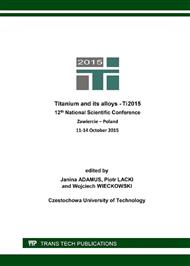[1]
M. Long, H.J. Rack, Titanium alloys in total joint replacement-a materials science perspective, Biomaterials 19 (1998) 1621-1639.
DOI: 10.1016/s0142-9612(97)00146-4
Google Scholar
[2]
H.J. Rack, J.I. Qazi, Titanium alloys for biomedical applications, Mater. Sci. Eng. C 26 (2006) 1269-1277.
Google Scholar
[3]
M. Geetha, A.K. Singh, R. Asokamani, A.K. Gogia, Ti based biomaterials, the ultimate choice for orthopaedic implants – A review, Prog. Mater. Sci. 54 (2009) 397-425.
DOI: 10.1016/j.pmatsci.2008.06.004
Google Scholar
[4]
K. Kieswetter, Z. Schwartz, T.W. Hummert, D.L. Cochran, J. Simpson, D.D. Dean, B.D. Boyan, Surface roughness modulates the local production of growth factors and cytokines by osteoblast-like MG-63 cells, J. Biomed. Mater. Res. 32 (1996) 55-63.
DOI: 10.1002/(sici)1097-4636(199609)32:1<55::aid-jbm7>3.0.co;2-o
Google Scholar
[5]
Y.T. Sul, C. Johansson, E. Byon, T. Albrektsson, The bone response of oxidized bioactive and non-bioactive titanium implants, Biomaterials 26 (2005) 6720-6730.
DOI: 10.1016/j.biomaterials.2005.04.058
Google Scholar
[6]
K. Duan, R. Wang, Surface modifications of bone implants through wet chemistry, J. Mater. Chem. 16 (2006) 2309-2321.
DOI: 10.1039/b517634d
Google Scholar
[7]
R.B. Heimann, Structure, propertie , and biomedical performance of osteoconductive bioceramic coatings, Surf. Coat. Technol. 233 (2013) 27-38.
DOI: 10.1016/j.surfcoat.2012.11.013
Google Scholar
[8]
Q. Chen, L. Cordero-Arias, J.A. Roether, S. Cabanas-Polo, S. Virtanen, A.R. Boccaccini, Alginate/Bioglass® composite coatings on stainless steel deposited by direct current and alternating current electrophoretic deposition, Surf. Coat. Technol. 233 (2013).
DOI: 10.1016/j.surfcoat.2013.01.042
Google Scholar
[9]
A. Lugovskoy, S. Lugovskoy, Production of hydroxyapatite layers on the plasma electrolytically oxidized surface of titanium alloys, Mater. Sci. Eng. C 43 (2014) 527-532.
DOI: 10.1016/j.msec.2014.07.030
Google Scholar
[10]
A. Kazek-Kęsik, G. Dercz, I. Kalemba, J. Michalska, J. Piotrowski, W. Simka, Surface treatment of a Ti6Al7Nb alloy by plasma electrolytic oxidation in a TCP suspension, Arch. Civ. Mech. Eng. 14 (2014) 671–681.
DOI: 10.1016/j.acme.2013.10.008
Google Scholar
[11]
H. Cimenoglu, M. Gunyuz, G.T. Kose, M. Boydogan, F. Ugurlu, C. Sener, Micro-arc oxidation of Ti6Al4V and Ti6Al7Nb alloys for biomedical applications, Mater. Characterization 62 (2011) 304-311.
DOI: 10.1016/j.matchar.2011.01.002
Google Scholar
[12]
T. Moskalewicz, A. Kruk, M. Kot, S. Kayali, A. Czyrska-Filemonowicz, Characterization of microporous oxide layer synthesized on Ti–6Al–7Nb alloy by micro-arc oxidation, Arch. Civ. Mech. Eng. 14 (2014) 370-375.
DOI: 10.1016/j.acme.2013.09.002
Google Scholar
[13]
L. H Li, Y.M. Kong, H.W. Kim, Y.W. Kim, H.E. Kim, S.J. Heo, J. Y Koak, Improved biological performance of Ti implants due to surface modification by micro-arc oxidation, Biomaterials 25 (2004) 2867-2875.
DOI: 10.1016/j.biomaterials.2003.09.048
Google Scholar
[14]
D. Teker, F. Muhaffel, M. Menekse, N.G. Karaguler, M. Baydogan, H. Cimenoglu, Characteristics of multi-layer coating formed on commercially pure titanium for biomedical applications, Mater. Sci. Eng. C 48 (2015) 579-585.
DOI: 10.1016/j.msec.2014.12.058
Google Scholar
[15]
Y. Han, J. Sun, X. Huang, Formation mechanism of HA-based coatings by micro-arc oxidation, Electrochem. Commun. 10 (2008) 510-513.
DOI: 10.1016/j.elecom.2008.01.026
Google Scholar


